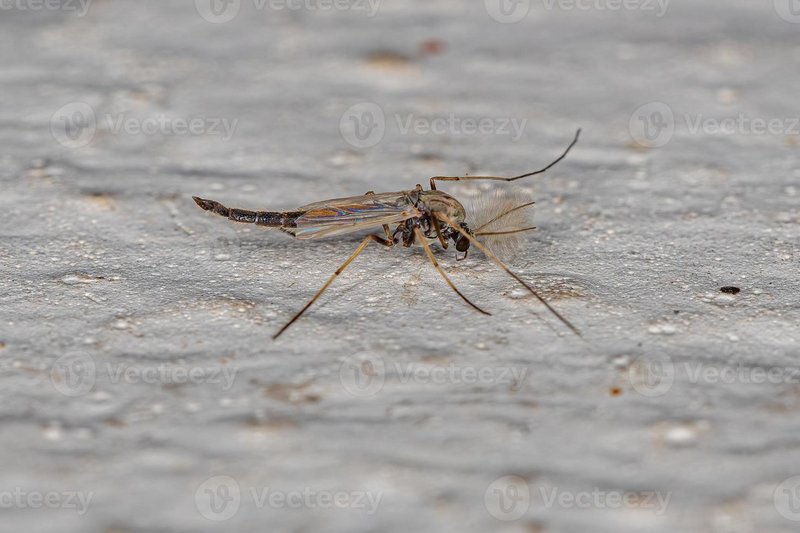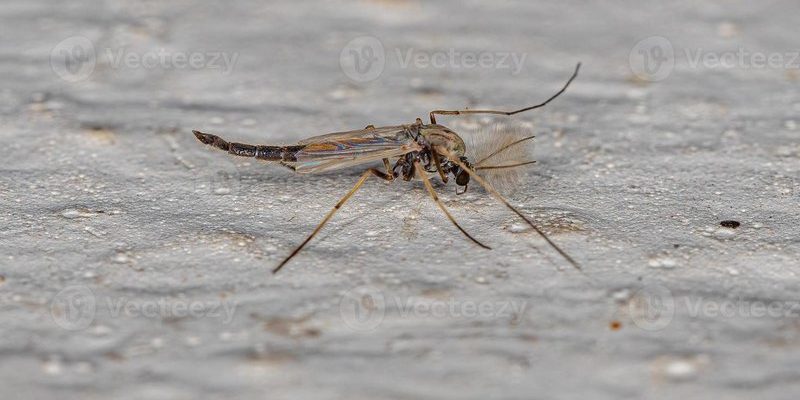
Imagine a tiny flying creature, so small that it seems almost invisible until it’s right in front of your face. That’s a midge! These little insects belong to the family of flies, and while many people are familiar with mosquitoes, midges are like their lesser-known cousins. They often buzz around freshwater areas like ponds and marshes, and while they might be bothersome, they also play important roles in their ecosystems.
There are over a thousand species of midges, and they come in various sizes and colors. Some of them are more troublesome than others. For example, the female midge is known for its biting abilities, making it a notorious pest during warm months. However, many species are harmless and even beneficial to local wildlife. Understanding these fascinating creatures can help us appreciate the delicate balance of nature.
Physical Characteristics
When you first catch sight of a midge, you might think it’s just a speck of dust caught in the sunlight. Adult midges typically measure about 1 to 3 millimeters in length. Their bodies are slender and often covered in a fine layer of hair, which gives them a fuzzy appearance. Despite their small size, they have long, delicate wings that can make them look almost fragile. You might notice them hovering near water or flying in small swarms.
Midges are usually brown or gray, but color can vary significantly by species. Their distinctive long, thread-like antennae help them navigate through their environment. The males often have bushier antennae, making them look a bit like they’re sporting a fancy hairdo. This is especially true when they dance in the air seeking mates, creating a spectacle that can be quite mesmerizing.
Life Cycle of a Midge
The life cycle of a midge is a journey of transformation, consisting of four main stages: egg, larva, pupa, and adult. The female midge lays hundreds of eggs in or near water. When these eggs hatch, the larvae emerge and live in the water, feeding on organic debris and algae. At this stage, they are often called “wigglers” because of their wiggling movements. This can be a critical food source for fish and other aquatic animals.
As they grow, the larvae undergo several molts before entering the pupa stage. In this stage, they remain in a protective casing, usually in the sediment at the bottom of the water. It’s during this time that they prepare for their transformation into adults. After a couple of weeks, the adult midge emerges, ready to start the cycle all over again. They typically live only a few weeks, just long enough to mate and lay eggs.
Habitat and Distribution
Midges are found all over the world, but they thrive in areas with stagnant or slow-moving water. You can often spot them near lakes, ponds, marshes, and even swamps. They prefer these moist environments because it provides ideal conditions for their larvae. Notably, midge larvae can be found in a variety of habitats, from fresh to brackish water.
In colder climates, midges tend to be more prevalent during summer months when the temperature rises, whereas in warmer areas, they might be active year-round. They tend to form large swarms, which can make them particularly annoying during outdoor activities. It can feel like nature’s version of a crowded party, with midges flying around in dance-like formations.
Diet and Feeding Habits
Adult midges have different dietary preferences compared to their larvae. While midge larvae are mostly detritivores, feeding on decomposing organic material in the water, adult midges primarily consume nectar from flowers. This makes them important pollinators for some plants. They can often be seen flitting from one blossom to another, gathering food while contributing to the ecosystem.
Interestingly, the female midge, especially those belonging to certain species, requires blood meals for reproduction. This is where things can get irritating for humans. When they bite, it can lead to itchy, uncomfortable welts. However, not all midges bite; many species are harmless and focus solely on nectar for sustenance.
Importance in the Ecosystem
Midges may seem like nuisances, but they play essential roles in their ecosystems. As larvae, they help break down organic materials, contributing to nutrient cycling in aquatic systems. They serve as food for a variety of fish, amphibians, and birds alike. Essentially, they are a crucial part of the food web, supporting larger wildlife.
Additionally, as adult midges pollinate flowers, they help plants reproduce, which in turn supports biodiversity. Many fish species rely on midges as a primary food source, especially in their early life stages. So, while they might buzz around your picnic, they are part of a complex and vital ecosystem!
How to Control Midge Populations
If you’ve experienced the annoyance of midges at your outdoor gathering, you’re not alone! While it’s tough to completely eliminate them, there are steps you can take to manage their populations. First and foremost, consider removing standing water around your home. This cuts down on where females can lay their eggs.
Using insect repellent sprays can help keep midges at bay during peak activity times, which are often at dawn and dusk. Wearing light-colored clothing and avoiding floral patterns can also make you less attractive to these flying pests. Additionally, if you have a pond or pool, using natural predators like fish can help control the midge larva population.
Interesting Facts About Midges
| Species Count: | Over 1,000 known species |
| Size: | 1 to 3 millimeters in length |
| Habitat: | Freshwater areas like ponds and marshes |
| Diet: | Learvae are detritivores; adults feed on nectar |
| Life Cycle: | Egg, larva, pupa, adult |
| Mating Behavior: | Male midges dance in swarms to attract females |
| Pollination: | Important for some flowering plants |
Midges may be small, but they embody the intricate relationships that exist in nature. From their role in the ecosystem to their fascinating life cycle, understanding midges opens up a whole new perspective on the natural world around us. The next time you notice these tiny creatures buzzing nearby, consider how they contribute to the balance of life in our environments. Even the smallest insects can have a big impact!
FAQ
Why are midges attracted to certain areas?
Midges are drawn to areas with stagnant or slow-moving water, as these environments provide the perfect conditions for laying eggs. They love warm, humid areas where vegetation is plentiful, as it offers both nectar for adults and shelter for larvae. If you’re near a pond or marsh, you’re likely to encounter midges, especially during warmer months.
Do midges bite humans?
Yes, certain species of midges do bite, particularly females. They require blood to develop their eggs, which can lead to itchy welts on human skin. However, not all midges bite, so you might encounter some species that are harmless. It’s always good to be cautious when in areas known for midge activity!
How can I prevent midge bites?
To avoid midge bites, consider using insect repellent that contains DEET or other effective ingredients. Wearing light-colored clothing and avoiding floral patterns can also minimize your attraction to these pests. Try to stay indoors during dawn and dusk when midges are most active, and if you’re outside, use screens or nets to create a barrier.
What do midge larvae look like?
Midge larvae, often called wigglers, are small and usually have a soft, elongated body that can be greenish or brownish in color. They can be found wriggling through the mud or swimming in the water, feeding on organic matter. They are typically just a few millimeters long, making them relatively easy to overlook if you’re not specifically looking for them!
Are midges beneficial to the environment?
Absolutely! Midges play a crucial role in the ecosystem. Their larvae help break down organic materials in the water, recycling nutrients back into the environment. Adults, particularly those that feed on nectar, also serve as pollinators for various plants, contributing to plant reproduction and supporting overall biodiversity.
Can midges be harmful to animals?
While midges can be annoying to humans, they can also pose a threat to some animals. The bites of biting midge species can cause discomfort and irritation in pets and livestock. However, they are generally not lethal. Nevertheless, keeping pets away from areas where these insects are prevalent can help minimize irritation.
Do midges have predators?
Yes, midges have several natural predators, including fish, birds, and some insects. Many fish species rely on midge larvae as a primary food source. Additionally, birds like swallows and other insectivores feed on adult midges. This natural predation helps keep midge populations in check in their habitats.
How long do midges live?
The lifespan of a midge varies depending on the species and environmental conditions. Generally, adult midges live for just a few weeks. During this time, their main focus is to mate and reproduce. The entire life cycle, from egg to adult, can take a few weeks to several months, depending on factors like temperature and food availability.
Are there any specific seasons when midges are more active?
Midges are most active during warm months, particularly in spring and summer. In cooler climates, their activity decreases significantly in the fall and winter, as larvae may hibernate in the substrate during harsh conditions. When temperatures rise, adult midges emerge from their pupal casings, leading to noticeable swarms, especially near water sources.
How do midges affect fishing?
Midges have a significant impact on fishing, particularly in freshwater environments. Many anglers use fly patterns that mimic midge larvae or adults, especially during the summer when these insects are abundant. Fish such as trout often feed on midges, making them an essential part of their diet. Understanding midge activity can help anglers improve their catch rates!
Can midges be found in urban areas?
Yes, midges can inhabit urban areas, particularly if there are stagnant water sources nearby, like ponds, retention basins, or even poorly drained ditches. However, the density of midge populations in urban environments is often lower than in rural areas. Still, during certain seasons, you may find them buzzing around parks or other green spaces.
What is the difference between midges and mosquitoes?
While midges and mosquitoes share some similarities, they are quite distinct. Midges are generally smaller than mosquitoes and often do not have the same biting habits. Only female midges from certain species bite, while male midges typically feed on nectar. In contrast, most female mosquitoes do bite, seeking blood meals more frequently. Additionally, midges tend to swarm in larger groups than mosquitoes.

